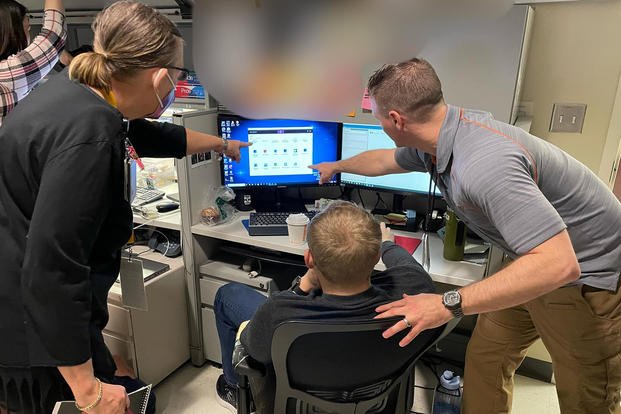Ten House Republicans have raised objections to new limits on military parents' access to their teenagers' medical records, calling the policies "reprehensible" and saying they restrict a parent's ability to make health decisions for their children.
A federal update in April to the Health Insurance Portability and Accountability Act's (HIPAA) privacy rules modified the circumstances in which a person's health information can be disclosed, particularly regarding reproductive health care.
The modification followed the Supreme Court's decision in 2022 to overturn Roe v. Wade and prohibits doctors, insurance companies and other health organizations from disclosing patient information to state officials for investigations or civil or criminal cases.
Read Next: Pilots, Family Members Say Crew Is Being Unfairly Blamed for November's Deadly Air Force Osprey Crash[1]
Just prior to the change, the Defense Health Agency published guidance saying that, in the military health system, parents of minors 12 and under have full access to their children's health records in MHS Genesis, the Defense Department's electronic health records system, but those with dependents ages 13 to 17 will have access only to appointment information, messaging, vaccination records and allergy care.
Although HIPAA's privacy rule permits parents to access minor children's medical records, there are exceptions, depending on state laws, that shield adolescents seeking care for mental or sexual health, including birth control and pregnancy, and other reasons.
The DoD's Parental Access to Protected Health Information of Unemancipated Minors Memorandum[2], published last year, said the department will follow federal and state privacy laws within the United States, while a March 2023 DoD memo allows dependent minors to get care at military hospitals and clinics overseas for birth control, reproductive health conditions and sexually transmitted diseases without parental consent.
The new DoD limitations have rankled some Republican lawmakers who say the policies allow providers to determine whether adolescents are capable of making their own health care decisions and violate parental rights.
According to the group, led by Rep. Mark Alford, R-Mo., the lack of access is "problematic" and "creates undue burdens on these parents."
"Adolescent children or teenagers under the age of 18 are prohibited from voting, drinking alcohol, using tobacco, and many other actions that vary across federal and state law because they are not mature enough to make appropriate decisions regarding their own welfare. Health care decisions should be no different," wrote the lawmakers in an Aug. 5 letter to Assistant Secretary of Defense for Health Affairs Dr. Lester Martinez-Lopez.
The group also alleges that the changes preclude parents "from finding out if their child is 'identifying' as another gender."
According to the letter, a minor also may be deemed as mature and seek such care as having "their reproductive organs removed" without necessitating parental notification.
DoD policy specifically states there are situations in which a provider "may have to notify" a parent or legal sponsor, including life-threatening conditions, those that require removal of reproductive organs or behavior that includes potential harm to themselves or others.
But the lawmakers said the records policy language means there may be situations in which military parents overseas don't have a chance to engage with their child about a life-changing decision before the dependent is about to have a procedure.
"Even then, the provider may not decide it is necessary to notify the child's parents. This policy is reprehensible," they wrote.
The lawmakers asked Martinez-Lopez to reconsider the policies.
Adam Greene, a former Department of Health and Human Services regulator and partner with the Washington, D.C.-based law firm Davis Wright Tremaine, said the military policy is "actually very typical."
"We have this complicated relationship where HIPAA defers to state law on whether the minor ... needs the parents' consent, but then HIPAA will essentially control based on whatever the result is as to whether the parent has access," Greene said in an interview Thursday with Military.com.
State laws vary widely when it comes to allowing adolescents to make their own health decisions, but many allow young people to act on their own behalf for reproductive care, mental health and substance use disorder, or illnesses like sexually transmitted diseases that teens may not want parents to know about or whose disclosure could cause harm to the patient.
The creation of patient portals -- the interface between providers, electronic health records and patients with access to electronic health records -- has complicated privacy issues related to medical care, according to Greene.
In a perfect world, the portals would have an option in which providers could click a box for patients under 18 to mask protected medical care while allowing parents to see treatment for acute or chronic conditions that isn't private, Greene said.
But the technology is not built that way.
"This is bipartisan concern -- conservative concerns, and on the liberal side, it is impeding care -- potentially -- to not provide parents with immediate patient portal access to, for example, their child's oncology information. I think the key is improved technological solutions," Greene said.
A study published in the Journal of Pediatrics in 2022 found that the variability in state laws "complicates their interpretation" when considering the HIPAA regulations and health care standards.
According to lead author Dr. Marianne Sharko, with the Departments of Population Health Sciences and Pediatrics at Weill Cornell Medicine, the evidence "demonstrates that adolescents are more likely to seek health care for potentially sensitive issues such as sexuality, mental health and drug use if they can provide their own consent and be confident that their health information is private."
"However, parents and guardians also have responsibilities pertaining to care for minor patients," she wrote.
Defense Health Agency officials did not respond to a request for comment on the letter by publication.
In a statement accompanying the press release on the policy in March, however, Dr. Anmarie Widener, chief of the Defense Health Agency's Privacy and Civil Liberties Office, said the new HIPAA Privacy Rule "gives clear guidance" on protecting Americans' health information, and minors are included in the rule.
Officials also urged patients to look at their state laws regarding teens' ability to consent to health treatment without parental notification.
"Each of the 50 states, U.S. territories, and the District of Columbia have their own rules for when a minor can consent to the care they get. The DHA observes those state-by-state rules under all circumstances," DHA officials wrote.
In addition to Alford, the letter was signed by Republican Reps. Elise Stefanik of New York, Michael Waltz and Cory Mills of Florida, Doug Lamborn of Colorado, Rich McCormick of Georgia, Ben Cline of Virginia, Harriet Hageman of Wyoming, Pat Fallon of Texas, and James Moylan of Guam.
Related: An Army Couple Had Their Daughter at a Military Hospital. Then the Collections Calls Started for $600,000.[3]
© Copyright 2024 Military.com. All rights reserved. This article may not be republished, rebroadcast, rewritten or otherwise distributed without written permission. To reprint or license this article or any content from Military.com, please submit your request here[4].
 Marine Corps Lance Cpl. Roy Mitchell Wheat had only been in charge of a security team in Vietnam for two short months when he lost his life. His selfless actions, which involved throwing himself onto a landmine to keep his fellow Marines from being
Marine Corps Lance Cpl. Roy Mitchell Wheat had only been in charge of a security team in Vietnam for two short months when he lost his life. His selfless actions, which involved throwing himself onto a landmine to keep his fellow Marines from being
 Marine Corps Lance Cpl. Roy Mitchell Wheat had only been in charge of a security team in Vietnam for two short months when he lost his life. His selfless actions, which involved throwing himself onto a landmine to keep his fellow Marines from being
Marine Corps Lance Cpl. Roy Mitchell Wheat had only been in charge of a security team in Vietnam for two short months when he lost his life. His selfless actions, which involved throwing himself onto a landmine to keep his fellow Marines from being

